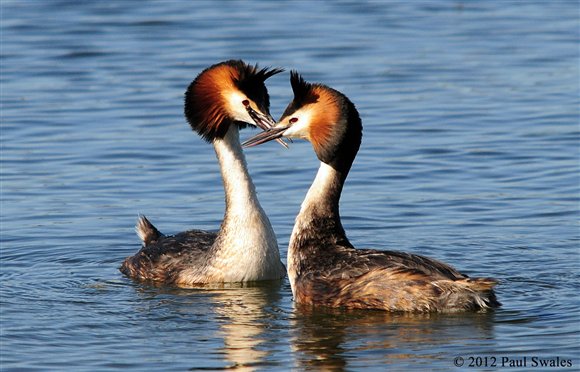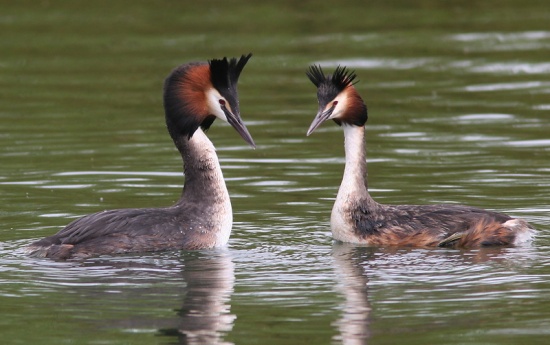
Podiceps cristatus
TAXONOMY
Colymbus cristatus, Linnaeus, 1758, Sweden. Three subspecies.
OTHER COMMON NAMES
French: Grиbe huppй; German: Haubentaucher; Spanish: Somormujo
Lavanco.
PHYSICAL CHARACTERISTICS
18–24 in (46–61 cm), P. c. infuscatus smallest; 1.3–3.3 lb
(568–1,490 g), heaviest while staging. Adult breeding: crown
black elongated to two posterior “horns” that can be raised and
spread; rest of upperparts blackish; sides of head white (upper
lores and supercilium black in infuscatus) grading to chestnut
on large posterior fan with black rear edge; underparts white,
upper sides washed with dusky; secondaries, tips of inner primaries,
lesser wing-coverts and scapulars white. Eyes red, bill
pink with dusky ridge. Nonbreeding: crest short, sides of head
white with no fan, immature similar but with several black
stripes on headside.
DISTRIBUTION
P. c. cristatus: Palaearctic, in winter in southern part of range,
mainly on coasts; P. c. infuscatus: Africa locally south of Sahara;
P. c. australis: Australia, Tasmania, and South Island, New
Zealand.
HABITAT
Mainly large lakes with expanses of open water and reedy bays,
but also brackish water, and tolerates heavily eutrophicated and
disturbed environments such as city parks.
BEHAVIOR
Alone or on pairs, in staging areas in groups of hundreds, occasionally
up to 10,000 together.
FEEDING ECOLOGY AND DIET
Mainly feeds on relatively large fish, usually in fairly deep water,
but also takes frogs, crustaceans, squid and other invertebrates.
REPRODUCTIVE BIOLOGY
Courtship display well developed. Nest often placed near that
of a coot. One or two broods per year. Up to 9 eggs, but usually
3–5. Incubation period 25–29 days. Young carried 3–4
weeks, associated with parents until 8–10 weeks old, able to fly
at 10 weeks.
CONSERVATION STATUS
Nearly extirpated from parts of Europe in the 1800s owing to
hunting for the plume trade, but now common in Palaearctic
region, where increasing owing to eutrophication of lakes and
where the population is estimated at around 700,000 birds.
Less common in other parts of range and decreasing in parts
of Africa, probably owing to drowning in monofilament gill
nets. In New Zealand a drastic decline occurred since the arrival
of Europeans, but population now stable.
SIGNIFICANCE TO HUMANS
Formerly extensively hunted for “grebe fur.”
Photo Gallery of - Great crested grebe




 Animalia Life
Animalia Life